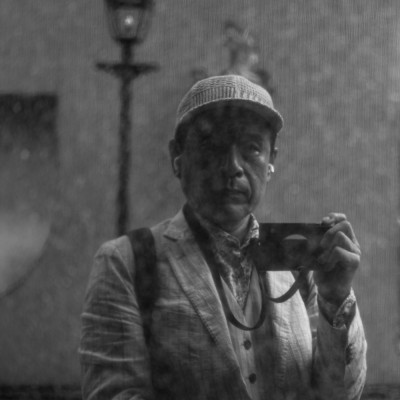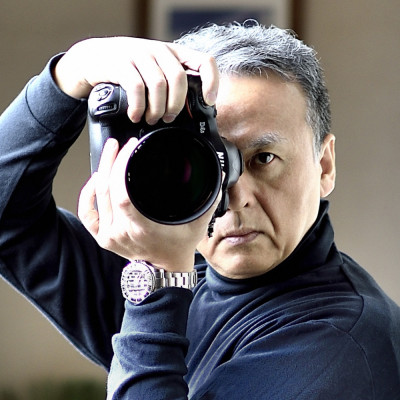SEARCH






|
|
|
|


Interview / tutorial by Editor Michel Romaggi in collaboration with the author Yuzo Fujii
Edited and published by Yvette Depaepe published the 17th of May 2022
Yuzo’s night street photos are full of life and beauty. They reveal picturesque characters appearing in magical places enhanced by the colourful neon lights and beautiful reflections on the wet sidewalks and pavements. He was kind enough to reveal some secrets of his wonderful night street shots.
'Ueno Shower'
Dear Yuzo, thank you very much for accepting to answer my questions.
Can you first introduce yourself and tell us what place photography has in your life?
I live near Tokyo and my office is located in the center of Tokyo. Most of my works were taken in that city.
I run a well-designed products company because I love art and design.
I've started photography 7 years ago. Photography is Art, I think. So now it's part of my life. In the beginning, I started with landscapes, looking for spectacular sceneries where many other photographers go, and took photos who weren't unique. But I wanted to show my originality by shooting famous places.
Recently, I found the right place to be to me, being street photography because I could combine original compositions, right timing, precious chances, stories and emotions all together in one photo. Craig Semetko, an American photographer, says that good photographs are based on a "DIET" with four key elements:
D: Design = geometry and composition
I: Information = context or story
E: Emotion = viewer feel something
T: Timing = perfect and right moment.
I agree with him and asked myself: "Is this pic fulfilling that DIET?" every time I shoot.
'Shinjuku Rainy Mood'
Can you tell us what specifically attracts you in such photographs? What are you trying to convey through them?
As I'm a businessman, I love shooting Tokyo night scenes not only because I'm a daytime business person, but also because it's more fun to take pictures at night. As you know, neons, lights, ..... colours of the Tokyo night scenes are so gorgeous and brilliant, and kind of random and chaotic. I like to compare it to "cyberpunk". You will not get bored of Tokyo night photography because you can take tons of different photographs even at the same place every day. You can express your originality in the composition and timing.
How do you choose the scenes you photograph?
In street photography, one thinks it is important to take photos of "emotions" on the subject's face, laugh, smile, tears, fears...
You all know the popular quote from Robert Capa : "If your pictures aren't good enough, you're not close enough". But, as you may know, Japanese tend not to overexpress emotions in public spaces. If you stand on this point of view, you will get stuck.
Also, taking a photo of a stranger's face is unacceptable in Japan. So I pay attention to the balance between subject/near view, middle view, and distant view. It's the same as for landscape photography. My goal is to take interesting photos of people in the near viewn story-telling in middle view and distant view to add a 3D perspective to the 2D photographs. I also love rain and umbrellas in street photography. Roads, grounds,...everything shines. You can take beautiful reflections on puddles. Colourful umbrellas and raincoats make your subjects really stand out.
'Telephone Box'
Can you tell us how you capture these snapshots of daily life?
In street candid photography, I normally use the pre-focus technique with range finder manual focus lenses, such as LEICA M series. I already design my composition before I shoot. I consider what is the middle view and what is the distant view for me.
Then I think about what and where the subject should be.
I point to the focus area there. It's almost pinpoint. Then, I wait until the right subject comes to the focus point. Wait, wait, and wait. If you are lucky, it's 5 minutes waiting. Sometimes 30 minutes... That's street photography.
But I enjoy being patient. It's still exciting. I'm not used to auto-focus tracking. I won't move the focus point by myself.
I love wide open large-aperture lenses like Noctilux(F0.95-F1.25), and Summilux (F1.4). Because I don't like high ISO noise, I want my subject to stand out and have dreamy look.
It's difficult to nail focus with F0.95, F1.25, and even F1.4 lenses in the case of candid street photography. That's why I use pre-focus tracking.
When you get done with it, you will have a maximum of satisfaction. Even at night, you will have an excellent separation between the subject and others and a wonderful clean low ISO photograph.
'Cyberpunk Tokyo'
What equipment did you use, what settings did you choose, and what steps to achieve 'Ueno shower'?
My recent all-camera gears are LEICA.
Before, I used Fujifilm's APS-C camera gears. I love Fujifilm's colour science. It's so amazing in good light conditions. But in dark circumstances, the APS-C format is a little shorter quality than the full-frame format. LEICA cameras/lenses are surprisingly outstanding in bad light conditions.
For this shot, the forecast said a sudden shower might happen in the afternoon. During the rain season, there are a lot of showers in Tokyo. That day, I was thinking about where I should take photos if it happens.
I love the scene where neons and signs light up raindrops and make roads shine.
Ueno's popular alley " AMEYA YOKOCHO" was one of the best locations..I stood at the entrance of AMEYA YOKOCHO. I love that position because you can look out over the alleywhich has a very nice curve.
It's rare that I take a zoom lens for street photography. But because of the weather, I took the LEICA Vario Elmarit SL 24-90mm lens with LEICA SL for weather sealing.
This lens widest aperture is F2.8. Shutter speed 1/125 sec, which I always choose for night street photography. With this shutter speed, you can stop people from moving with a rather low ISO setting. In that case, my auto ISO setting was 500.
'Kabukicho Reflection'
How did you post-processed it?
Recently, I purchased "DxO PureRAW 2". I also have the former version, but I haven't used it because it didn't support LEICA SL, SL2. DxO PureRAW 2 started to support lots of cameras such as LEICA, Fuji-X trans.
I tested to open UENO SHOWER's raw file with this application and was surprised to find the result was amazingly good! ISO noise is so clear! And the colours and tonalities are far better than Adobe Raw.
If you often use DxO PureRAW 2 supported camera, and you like night photography, I highly recommend you the free test software.
The view adds a 3D image to the composition. I think the "vanishing point" is important for a good photo.My Lightroom Post process setting was nothing special.
I love LightRoom's standard colour preset Cinematic. I selected CN04, for it.
No HDR, No photoshop.
'Tokyo Lantern Alley'
 | Write |
 | Yanyan Gong PRO What a beautiful collection, and I love the "DIET" theory, true for all types of photography! Thank you very much for sharing! |
 | Yuzo Fujii PRO WOW!! Thank you for watching and reading! I'm so honored! |
 | Francisco Goncalves PRO Wonderful work and mood. An attractive combination of colour, space and shapes. |
 | Yuzo Fujii PRO Francisco Goncalves, Thank you for the comment! I'm so honred. |
 | Takahide Makino PRO 藤井さん!
マガジンで紹介されるなんてすごいですね〜〜。流石です!!
おめでとうございます😊 |
 | Yuzo Fujii PRO Takahide Makino さんご覧いただきありがとうございます~!世界に見てもらえて嬉しいです! |